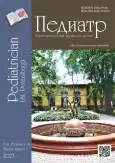Features of intestinal microbiota in chronic pyelonephritis in a patient with Mayer–Rokitansky–Kustner–Hauser syndrome
- Authors: Lagutina S.N.1, Skuratova O.S.1, Chizhkov P.A.1, Zuykova A.A.1, Kurguzova A.S.1, Esina E.Y.1, Dobrynina I.S.1, Martynenko D.A.1, Samkov K.D.1
-
Affiliations:
- N.N. Burdenko Voronezh State Medical University
- Issue: Vol 14, No 3 (2023)
- Pages: 139-146
- Section: Clinical observation
- URL: https://journals.rcsi.science/pediatr/article/view/254592
- DOI: https://doi.org/10.17816/PED143139-146
- ID: 254592
Cite item
Abstract
Mayer–Rokitansky–Küstner–Hauser syndrome is a congenital anomaly in the development of the female reproductive system, the essence of which is a violation of the intrauterine development of the Müllerian ducts, causing complete aplasia of the vagina and uterus. Deviation is a total or partial absence uterus, two upper thirds of the vagina, most often in combination with various anomalies of organs and systems, such as excretory, cardiovascular. Currently, the causes of this pathology are not fully understood studied. According to the World Health Organization, the percentage of hereditary factors intrauterine development disorders is approximately 10 to 25%. It is known that patients with this pathology often suffer from diseases of the urinary system (pyelonephritis). Chronic pyelonephritis is a common pathology in any age group due to excessive growth of the bacterial flora. The main causative agent, most often, are representatives of the intestinal microbiota (Escherichia coli, Enterococcus, Staphylococcus). Determination of the genus and species composition of the intestinal microbiota can serve as one of the diagnostic signs that contribute to the timely correction of the main therapy. Presented clinical case demonstrates a change in the biodiversity of the intestinal microbiota in a patient with Mayer–Rokitansky–Küstner–Hauser syndrome, which entails timely correction of drug therapy regimens in relation to chronic pyelonephritis and achieving remission. Thus, the study of changes in the composition of the intestinal microflora can become a new criterion in the diagnosis and treatment of this disease at an early stage.
Full Text
##article.viewOnOriginalSite##About the authors
Svetlana N. Lagutina
N.N. Burdenko Voronezh State Medical University
Author for correspondence.
Email: svlagutina97@mail.ru
Resident Doctor, Department of Polyclinic Therapy
Russian Federation, VoronezhOlga S. Skuratova
N.N. Burdenko Voronezh State Medical University
Email: prokopova15@mail.ru
Resident Doctor, Department of Polyclinic Therapy
Russian Federation, VoronezhPavel A. Chizhkov
N.N. Burdenko Voronezh State Medical University
Email: qooleer@yandex.ru
Resident Doctor, Department of Polyclinic Therapy
Russian Federation, VoronezhAnna A. Zuykova
N.N. Burdenko Voronezh State Medical University
Email: zuikova@vrngmu.ru
MD, PhD, Dr. Med. Sci., Professor, Head, Department of Polyclinic Therapy
Russian Federation, VoronezhAnastasia S. Kurguzova
N.N. Burdenko Voronezh State Medical University
Email: kuguzova@vrngmu.ru
Assistant Professor, Department of Polyclinic Therapy
Russian Federation, VoronezhElena Yu. Esina
N.N. Burdenko Voronezh State Medical University
Email: esina@vrngmu.ru
MD, PhD, Dr. Med. Sci., Professor, Department of Polyclinic Therapy
Russian Federation, VoronezhIrina S. Dobrynina
N.N. Burdenko Voronezh State Medical University
Email: dobrynina@yandex.ru
MD, PhD, Associate Professor, Department of Polyclinic
Russian Federation, VoronezhDaria A. Martynenko
N.N. Burdenko Voronezh State Medical University
Email: dsmart@yandex.ru
6th year student of the Faculty of Medicine, Department of Polyclinic Therapy
Russian Federation, VoronezhKirill D. Samkov
N.N. Burdenko Voronezh State Medical University
Email: kdsamkov@yandex.ru
6th year student of the Faculty of Medicine, Department of Polyclinic Therapy
Russian Federation, VoronezhReferences
- Smol’nova TYu, Bobkova MV, Asaturova AV, et al. Are there phenotypic manifestations of connective tissue dysplasia syndrome in patients of reproductive age with aplasia of the vagina and uterus? Russian Bulletin of Obstetrician-Gynecologist. 2021;21(2):7381. (In Russ.) doi: 10.17116/rosakush20212102173
- Berg G, Rybakova D, Fischer D, et al. Microbiome definition re-visited: old concepts and new challenges. Microbiome. 2020;8:103. doi: 10.1186/s40168-020-00875-0
- Dry J, Bessede T, Patard JJ. Management of acute pyelonephritis. Progrès en Urologie. 2022;22(14): 871–875. (In French) doi: 10.1016/j.purol.2012.06.002
- Hillman ET, Lu H, Yao T, Nakatsu CH. Microbial ecology along the gastrointestinal tract. Microbes Environ. 2017;32(4):300–313. doi: 10.1264/jsme2.ME17017
- Lagrine M, Bennaoui F, El Idrissi Slitine N, Rabou Maoulainine F. Epidemiology of urinary tract infection in neonatal intensive care unit of Mohammed VI University Hospital in Marrakech. Open Infect Dis J. 2018;10: 156–159. doi: 10.2174/1874279301810010156
- Meštrović T, Matijašić M, Perić M, et al. The role of the gut, vagina, and urinary tract microbiome in urinary tract infections: from bench to bedside. Diagnostics (Basel). 2021;11(1):7. doi: 10.3390/diagnostics11010007
- Nishioka H, Doi A, Takegawa H. Pyelonephritis in Japan caused by Salmonella enterica subsp. Arizonae. J Infect Chemother. 2017;23(12):841–843. doi: 10.1016/j.jiac.2017.08.001
- Praetorius H. Bacteria and the host: a history of purinergic signaling in urinary tract infections. Am J Physiol Cell Physiol. 2021;321(1): C134–C146. doi: 10.1152/ajpcell.00054.2021
- Rinninella E, Raul P, Chintoni M, Franceschi F, et al. What is the composition of a healthy gut microbiota? A changing ecosystem with age, rare occurrences, nutrition and infections. Microorganisms. 2019;7(1):14. doi: 10.3390/microhorogisms7010014
- Stecher B. Roles of inflammation, nutrient availability, and commensal microbiota in intestinal pathogenic infection. Microbiol Spectr. 2015;3:3. doi: 10.1128/microbiolspec.MBP-0008-2014
- Stepanova N. How advanced is our understanding of the role of intestinal barrier dysfunction in the pathogenesis of recurrent urinary tract infections. Front Pharmacol. 2022;13:780122. doi: 10.3389/fphar.2022.780122
- Sturov NV, Popov SV, Zhukov VA, et al. Intestinal microbiota correction in the treatment and prevention of urinary tract infection. Urol Res Pract. 2022;48(6): 406–414. doi: 10.5152/tud.2022.22119
- Warby K.J., Olson B.S., Dodson K.W., et al. Establishing the role of the gut microbiota in susceptibility to recurrent urinary tract infections // J Clin Invest. 2022. Vol. 132, No. 5. ID e158497. doi: 10.1172/JCI158497
- www.rlsnet.ru [Internet]. Ehnterol. Available at: https://www.rlsnet.ru/drugs/enterol-3539 (In Russ.)
Supplementary files






